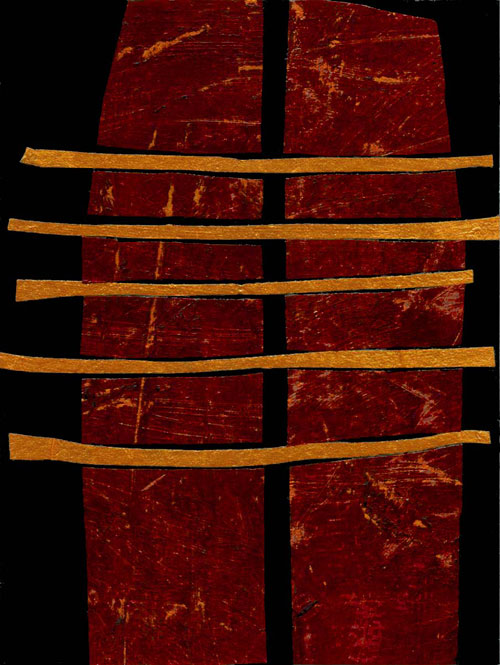
The Two Commandments © Jan L. Richardson
Reading from the Gospels, Year A, Proper 25/Ordinary 30/Pentecost +19: Matthew 22.34-46
I came home from a recent trip to the library with an armload of books from the art department. From Arts & Crafts of Morocco to The Art of Japanese Calligraphy to Medieval and Renaissance Art and beyond, the books are providing savory fare for my hungry eyes in this season of needing some new sustenance in my practice as an artist. Today at teatime, my book of choice was Shaker Design, a catalog from an exhibit cosponsored by the Whitney Museum of American Art and the Corcoran Gallery of Art in the 1980s.
June Sprigg, the author of Shaker Design, writes,
The Shakers were not conscious of themselves as “designers” or “artists,” as those terms are understood in modern times. But they clearly worked to create a visible world in harmony with their inner life: simple, excellent, stripped of vanity and excess. Work and worship were not separate in the Shaker world. The line between heaven and earth flickered and danced. “A Man can Show his religion as much in measureing onions as he can in singing glory hal[le]lu[jah],” observed one Believer. Thomas Merton attributed the “peculiar grace” of a Shaker chair to the maker’s belief that “an angel might come and sit on it.”
I am fascinated by the elegant simplicity that the Shakers brought to the work of their hands. The lines of Shaker design seem to emerge directly from their sense of what is most essential; follow the simple curve of a bowl, the uncluttered planes of a cupboard or dresser or table, the weave of a basket, and you can see how it has been created by someone who managed to strip away all that wasn’t necessary, who found the heart of the piece.
As an artist whose work has become increasingly spare the past few years, I am drawn to and challenged by such designs, curious about how others—in a variety of media—have found their way to the lines of their handiwork. Looking at a Shaker chair, a Japanese tea bowl, an Amish quilt, I wonder, What did their makers have to pare away in order to discover what was essential? How did they find their way to the heart of the matter?
It’s these kinds of questions that we see Jesus engaging in this Sunday’s gospel lection. “Teacher,” a lawyer from the religious establishment asks him, “which commandment in the law is the greatest?” Designed to test him, the question nonetheless prompts Jesus to lay out the lines that lie at the core of his life and teaching: “‘You shall love the Lord your God with all your heart, and with all your soul, and with all your mind,'” Jesus says to the lawyer and to the others within earshot. ‘And a second is like it: ‘You shall love your neighbor as yourself.’ On these two commandments hang all the law and the prophets.”
Firmly rooted in his Jewish heritage, Jesus gathers up the wisdom of his forebears and distills it into these two commandments that stand at the center of his history and of our own. He has found the heart of the matter, bringing to light what is most important, what is most crucial and essential in our life together.
Jesus knows that arriving at and living into what is essential is rarely easy. With these two commandments, Jesus extends a call that is compelling in its utter directness and seeming simplicity, yet the work of love—loving God and one another and ourselves, with all the artfulness and creativity this asks of us—can be wildly complicated. Jesus’ words this week get at something I continually experience at the drafting table: arriving at something that appears simple and basic is one of the hardest things to do.
Maybe someday, in one of these reflections, I’ll include a picture of the box of scraps from my drafting table—all those pieces that I pared away, that I chose against, that I let go of in order to find the final design, the essential line, the heart of the matter. In the meantime, I am here to ask you: How do you do this in your own life? Where is Christ’s call to love—this call that draws us into the deepest places in our own hearts, the heart of the world, the heart of God—taking you? How do you sort through all that competes for your attention, so that you can find what is most crucial? What are the challenges along the way, and where do you find the presence of beauty and delight in the lines of your emerging life?
May the heart of God draw you in this week, and may you know the grace and power and beauty that come in discovering the design that God desires for you. Blessings!
P.S. For a previous reflection on this passage, see Crossing the Country, Thinking of Love.
[To use the “Two Commandments” image, please visit this page at janrichardsonimages.com. Your use of janrichardsonimages.com helps make the ministry of The Painted Prayerbook possible. Thank you!]













Leave a Reply